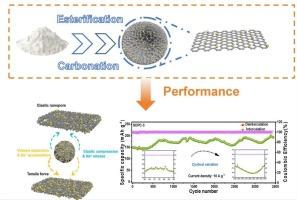Interfacial defect engineering of S/O dual-doped carbon nanostructures for advanced sodium-ion hybrid capacitors
IF 9.7
1区 化学
Q1 CHEMISTRY, PHYSICAL
引用次数: 0
Abstract
Porous carbon materials have important applications in energy storage and conversion due to sufficient raw materials, adjustable pore structure and specific surface area. However, developing porous carbons with both a simple preparation process and excellent performance remain a significant challenge. Herein, we propose synthesizing S/O co-doped porous carbon (SOPC-3) by regulating the S/O ratio and introducing abundant adsorption sites. According to electrochemical tests, SOPC-3 has a high Na+ storage capacity of 396.7 mAh g−1 at 1 A g−1. After 3500 cycles, it maintains 192.7 mAh g−1 at a current density of 10 A g−1. Combined with theoretical calculations and material characterization analysis, the excellent performance is attributed to the fact that the S/O co-doping promotes the reversible adsorption-desorption process of Na+, and the rich pore structure provides more ion diffusion paths. Meanwhile, the prepared by K2CO3-assisted KOH activated asphalt (KAC) maintains a reversible capacity of 69.0 mAh g−1 over 2400 cycles at a current density of 0.5 A g−1. Finally, at the power density of 140 W kg−1, the assembled sodium-ion hybrid capacitor (SOPC-3//KAC) demonstrates a high energy density of 104.2 Wh kg−1. This work provides important theoretical guidance for the design of high-performance carbon-based energy storage materials.

先进钠离子混合电容器中S/O双掺杂碳纳米结构的界面缺陷工程。
多孔碳材料原料充足、孔结构可调、比表面积可调,在能量存储和转化方面具有重要的应用。然而,开发制备工艺简单、性能优异的多孔碳仍然是一个重大挑战。为此,我们提出通过调节S/O比和引入丰富的吸附位点来合成S/O共掺杂多孔碳(SOPC-3)。电化学测试表明,SOPC-3在1 a g-1时具有396.7 mAh g-1的高Na+存储容量。经过3500次循环,它在10 a g-1的电流密度下保持192.7 mAh g-1。结合理论计算和材料表征分析,优异的性能归因于S/O共掺杂促进了Na+的可逆吸附-解吸过程,丰富的孔隙结构提供了更多的离子扩散路径。同时,k2co3辅助KOH活性沥青(KAC)在0.5 a g-1电流密度下,在2400次循环中保持69.0 mAh g-1的可逆容量。最后,在功率密度为140 W kg-1时,组装的钠离子混合电容器(SOPC-3//KAC)的能量密度高达104.2 Wh kg-1。这项工作为高性能碳基储能材料的设计提供了重要的理论指导。
本文章由计算机程序翻译,如有差异,请以英文原文为准。
求助全文
约1分钟内获得全文
求助全文
来源期刊
CiteScore
16.10
自引率
7.10%
发文量
2568
审稿时长
2 months
期刊介绍:
The Journal of Colloid and Interface Science publishes original research findings on the fundamental principles of colloid and interface science, as well as innovative applications in various fields. The criteria for publication include impact, quality, novelty, and originality.
Emphasis:
The journal emphasizes fundamental scientific innovation within the following categories:
A.Colloidal Materials and Nanomaterials
B.Soft Colloidal and Self-Assembly Systems
C.Adsorption, Catalysis, and Electrochemistry
D.Interfacial Processes, Capillarity, and Wetting
E.Biomaterials and Nanomedicine
F.Energy Conversion and Storage, and Environmental Technologies

 求助内容:
求助内容: 应助结果提醒方式:
应助结果提醒方式:


